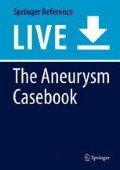Abstract
A 69-year-old male presented with a sudden onset severe headache after an episode of heavy coughing one morning. He was a heavy smoker and his medical history included chronic obstructive pulmonary disease (COPD). He was taken to the nearest hospital and underwent CT-scanning because of persistent headache. The CT revealed subarachnoid hemorrhage (SAH) in the anterior interhemispheric fissure, suggestive of an aneurysmal etiology. His clinical condition was graded as Hunt and Hess II. Emergent CT-angiography revealed multiple cerebral aneurysms including one arising from the distal anterior cerebral artery (DACA). A V-shaped aneurysm of the left anterior A3 segment (pericallosal artery) measuring 4 × 3 × 3 mm was identified as the most likely rupture site. Further aneurysms included an incidental 2 × 2 mm aneurysm of the left middle cerebral artery (MCA), a 3 × 2 mm left posterior communicating artery (PcomA) aneurysm and a 5 × 5 mm aneurysm of the basilar artery. DSA demonstrated a DACA aneurysm at the bifurcation of the callosomarginal artery (A3 segment of the distal ACA) on a single inferior A3 to A2 trunk, with a bilobar, V-shaped configuration. The aneurysm was wide-necked and it was not clear whether the associated callosomarginal artery was running adjacent to, or efferent from, this aneurysm. The decision to recommend emergent microsurgical clipping was based on an interdisciplinary risk-benefit analysis. Microsurgery was performed via a focused interhemispheric approach with aneurysm exclusion and vessel wall reconstruction aided by temporary clipping of the proximal A3 segment, with the patient’s head in a neutral position. The postoperative course was complicated by delayed weaning from the ventilator due to longstanding nicotine abuse, marked COPD and pulmonary emphysema. Forty-one days after the initial presentation, the patient was discharged without neurological deficit. Management aspects of DACA aneurysms including their characteristics and challenges are the main topic of this chapter.
References
Backes D, Vergouwen MD, Tiel Groenestege AT, Bor AS, Velthuis BK, Greving JP, Algra A, Wermer MJ, van Walderveen MA, terBrugge KG, Agid R, Rinkel GJ. PHASES score for prediction of intracranial aneurysm growth. Stroke. 2015;46(5):1221–6. https://doi.org/10.1161/STROKEAHA.114.008198.
Germans MR, Coert BA, Vandertop WP, Verbaan D. Time intervals from subarachnoid hemorrhage to rebleed. J Neurol. 2014;261(7):1425–31. https://doi.org/10.1007/s00415-014-7365-0.
Greving JP, Wermer MJ, Brown RD Jr, Morita A, Juvela S, Yonekura M, Ishibashi T, Torner JC, Nakayama T, Rinkel GJ, Algra A. Development of the PHASES score for prediction of risk of rupture of intracranial aneurysms: a pooled analysis of six prospective cohort studies. Lancet Neurol. 2014;13(1):59–66. https://doi.org/10.1016/S1474-4422(13)70263-1.
Kretschmer T, Schmidt T. Fall 9: Rupturiertes A3-Pericallosa-Aneurysma mit intrazerebraler und intraventrikulärer Blutung und weiterem A3-Aneurysma. In: Kretschmer T, editor. Zerebrale Aneurysmen und Gefäßmalformationen: Behandlungsgrundlagen und neurochirurgische Therapie in Fallbeispielen. Berlin/Heidelberg: Springer; 2017. p. 149–55. https://doi.org/10.1007/978-3-662-50478-9.
Lehečka M. Distal anterior cerebral artery aneurysms. Helsinki; 2009. https://helda.helsinki.fi/bitstream/handle/10138/22954/distalan.pdf?sequence=2
Lehečka M, Lehto H, Niemelä M, Juvela S, Dashti R, Koivisto T, Ronkainen A, Rinne J, Jääskeläinen JE, Hernesniemi JA. Distal anterior cerebral artery aneurysms: treatment and outcome analysis of 501 patients. Neurosurgery. 2008;62(3):590–601; discussion 590–601. https://doi.org/10.1227/01.neu.0000317307.16332.03.
Saponiero R, Toriello A, Locatelli G, Pugliese ND, Napoli AN, Napoli M, Siani A, Cuomo G, Panza MP, Narciso N, Posteraro L. Distal anterior cerebral artery aneurysms: endovascular or surgical treatment? A case report. Neuroradiol J. 2008;21(2):251–4. https://doi.org/10.1177/197140090802100217.
Sarikaya B, Oksuz E, Deniz FE, Firat MM. Endovascular treatment of a ruptured aneurysm at a very rare location. Distal azygos anterior cerebral artery. Interv Neuroradiol. 2008;14(4):457–60. https://doi.org/10.1177/159101990801400413.
Spetzler RF, Sanai N. The quiet revolution: retractorless surgery for complex vascular and skull base lesions. J Neurosurg. 2012;116(2):291–300. https://doi.org/10.3171/2011.8.JNS101896.
Steven DA, Lownie SP, Ferguson GG. Aneurysms of the distal anterior cerebral artery: results in 59 consecutively managed patients. Neurosurgery. 2007;60(2):227–33; discussion 234. https://doi.org/10.1227/01.NEU.0000249267.33945.E7.
Author information
Authors and Affiliations
Corresponding author
Editor information
Editors and Affiliations
Rights and permissions
Copyright information
© 2019 Springer Nature Switzerland AG
About this entry
Cite this entry
Rauter, H., Resch, A., Kretschmer, T. (2019). Anterior Cerebral Artery Aneurysm: Ruptured Distal Azygos Anterior Cerebral Artery Aneurysm; Interhemispheric Approach,Positioning of Head, Rationale Interhemispheric Approach, Positioning of Head, Rationale for Open Surgery. In: Henkes, H., Lylyk, P., Ganslandt, O. (eds) The Aneurysm Casebook. Springer, Cham. https://doi.org/10.1007/978-3-319-70267-4_105-1
Download citation
DOI: https://doi.org/10.1007/978-3-319-70267-4_105-1
Received:
Accepted:
Published:
Publisher Name: Springer, Cham
Print ISBN: 978-3-319-70267-4
Online ISBN: 978-3-319-70267-4
eBook Packages: Springer Reference MedicineReference Module Medicine

